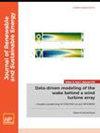基于 PSO-BP 优化的电动汽车二氧化碳热泵空调系统制热性能预测
IF 1.9
4区 工程技术
Q4 ENERGY & FUELS
引用次数: 0
摘要
用于电动汽车(EV)的二氧化碳热泵空调(HPAC)系统因其出色的低温加热能力而受到广泛关注。然而,电动汽车的续航能力受到电池储能的限制,这使得加热系统的能量需求会影响驱动电池的能量利用效率。为了衡量空调(AC)系统在制热方面的热经济性,通常采用性能系数(COP)指标。准确的 COP 预测有助于优化电动汽车热 HPAC 系统的性能,避免能源浪费,从而提高车辆的续航里程。在本研究中,我们使用反向传播(BP)神经网络结合粒子群优化(PSO)算法来预测和优化电动汽车 CO2 HPAC 系统的 COP。首先,建立了电动汽车 CO2 HPAC 系统的 COP 预测模型,该模型可考虑多种影响因素,并通过实验获得了影响交流系统 COP 的关键参数。其次,利用 BP 神经网络预测 CO2 HPAC 系统的 COP,为了克服 BP 神经网络速度慢、容易陷入最小值的缺点,引入粒子群算法 PSO 来优化 BP 神经网络的权值和偏置,从而提高预测的准确性和稳定性。通过本研究,我们将 BP 神经网络与 PSO 算法相结合,实现了对电动汽车 HPAC 系统 COP 的精确预测和优化,为提高能源利用效率提供了有力支持。其次,我们考虑了室外温度、压缩机转速、电动汽车状态等多种影响因素,使预测模型更加准确和适用。最后,本研究提出的方法在真实数据集上得到了验证,利用粒子群算法 PSO 对 BP 神经网络进行优化,可将 HPAC 系统 COP 预测的准确率提高 65.8%。本文章由计算机程序翻译,如有差异,请以英文原文为准。
Prediction of heating performance of carbon dioxide heat pump air conditioning system for electric vehicles based on PSO-BP optimization
CO2 heat pump air conditioning (HPAC) systems for electric vehicles (EVs) have received widespread attention for their excellent low-temperature heating capabilities. However, the range of EVs is limited by the battery energy storage, which makes the energy demand of the heating system affect the energy use efficiency of the drive battery. In order to measure the thermal economy of the air conditioning (AC) system in terms of heating, the index of coefficient of performance (COP) is often used. Accurate COP prediction can help optimize the performance of heat HPAC systems for EVs to avoid energy wastage and thus improve the range of the vehicle. In this study, we use a backpropagation (BP) neural network combined with the particle swarm optimization (PSO) algorithm to predict and optimize the COP of the CO2 HPAC system for EVs. First, a COP prediction model of the CO2 HPAC system for EVs was established, which can consider a variety of influencing factors, and the key parameters affecting the COP of the AC system were obtained through experiments. Second, a BP neural network is used to predict the COP of the CO2 HPAC system, and in order to overcome the shortcomings of the BP neural network, which is slow and prone to fall into the minimum value, the particle swarm algorithm PSO is introduced to optimize the weights and biases of the BP neural network, so as to improve the accuracy and stability of the prediction. Through this study, we combine the BP neural network with the PSO algorithm to achieve accurate prediction and optimization of the COP of the HPAC system of an EV, which provides a strong support for the improvement of energy use efficiency. Second, we considered a variety of influencing factors, such as outdoor temperature, compressor speed, and EV status, which made the prediction model more accurate and applicable. Finally, the method proposed in this study is validated on a real dataset, and the optimization of the BP neural network using the particle swarm algorithm PSO can improve the accuracy of COP prediction for HPAC systems by 65.8%.
求助全文
通过发布文献求助,成功后即可免费获取论文全文。
去求助
来源期刊

Journal of Renewable and Sustainable Energy
ENERGY & FUELS-ENERGY & FUELS
CiteScore
4.30
自引率
12.00%
发文量
122
审稿时长
4.2 months
期刊介绍:
The Journal of Renewable and Sustainable Energy (JRSE) is an interdisciplinary, peer-reviewed journal covering all areas of renewable and sustainable energy relevant to the physical science and engineering communities. The interdisciplinary approach of the publication ensures that the editors draw from researchers worldwide in a diverse range of fields.
Topics covered include:
Renewable energy economics and policy
Renewable energy resource assessment
Solar energy: photovoltaics, solar thermal energy, solar energy for fuels
Wind energy: wind farms, rotors and blades, on- and offshore wind conditions, aerodynamics, fluid dynamics
Bioenergy: biofuels, biomass conversion, artificial photosynthesis
Distributed energy generation: rooftop PV, distributed fuel cells, distributed wind, micro-hydrogen power generation
Power distribution & systems modeling: power electronics and controls, smart grid
Energy efficient buildings: smart windows, PV, wind, power management
Energy conversion: flexoelectric, piezoelectric, thermoelectric, other technologies
Energy storage: batteries, supercapacitors, hydrogen storage, other fuels
Fuel cells: proton exchange membrane cells, solid oxide cells, hybrid fuel cells, other
Marine and hydroelectric energy: dams, tides, waves, other
Transportation: alternative vehicle technologies, plug-in technologies, other
Geothermal energy
 求助内容:
求助内容: 应助结果提醒方式:
应助结果提醒方式:


